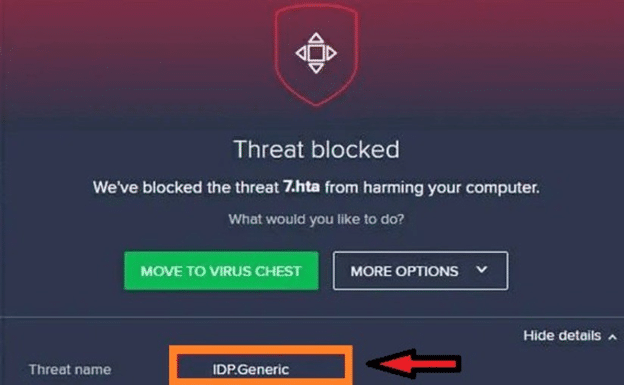Many Windows users get a virus detection of IDP.generic in their folders. Your antivirus will essentially give you a warning that it has detected an IDP.generic infected file. There is a wide variety of files that can be detected as corrupted with IDP.Generic. This IDP.generic threat is not associated with a single file. For instance, some users were experiencing the IDP.
Generic game file threat, although some users saw this threat while using a python file. Although this identification of threats is not unique to an antivirus, most of the users who encountered this used Avast antivirus. Obviously, you won’t be able to enjoy your games or other applications if your antivirus finds those viruses in files connected to your games. So a lot of people are concerned and want to make sure that it’s a false positive or a virus.
What Is the IDP.Generic Virus?
The IDP in this virus stands for Identity Detection Protection. The virus seeks to steal identification information, like banking or other personal data. It relates to your identity information. This threat can be one of two things:
- It can actually be a false positive, which means your antivirus program cannot recognize the file because it is labeled as a virus when it’s not even one.
- It can be a genuine computer virus known as a Trojan, malicious software that can extort or steal your money or even control your computer.

In situations where your system is experiencing a false positive, this simply means that there is a generic file on your hard drive that is not recognized by antivirus or other programs. This generally happens if you haven’t recently updated your software. Outdated software will not recognize newer file types, which may lead it to erroneously consider a perfectly appropriate file as a threat, since a pattern of code or behavior which appears to resemble a virus may be displayed.
How did IDP.Generic infiltrate my computer?
Trojan viruses like IDP.Generic are capable of entering the system in various ways. You might download the virus program, click a link in an email that silently installs your infected application, or click on the pop-up ad on a Web site that activates the virus.
Once a Trojan virus is opened, it behaves as a chain-response by uploading other malicious programs and leveraging weaknesses in ordinary programs, like depriving your completely normal email program.
You are at great risk for this or other trojans infiltrating the device whether you are using peer-to-peer networks (torrents, eMule, or related tools), free file hosting services, freeware sites for uploading, etc.
How to avoid installation of malware?
Download apps from official and reputable websites only and use direct download links. It is also necessary to keep applications up-to-date, but just use the resources or functions offered by official software developers.
Do not open email attachments if received from unknown/suspicious addresses. They are generally presented as official and significant, however, if they and their attachments are insignificant, they should be ignored. It is illegal to use ‘cracking’ software (activators), which bypass pay activation, and also trigger malware downloading and installation. Finally, to avoid system virus infection, use reputed anti-virus/anti-spyware tools.
How Do I Get Rid Of This Virus?
The easiest way to avoid sneaky computer software is to use good antivirus software that is capable of tackling any type of threat. This can take several hours to do so but they can delete malicious files most efficiently. There are other options, too.
- Due to the strong probability that IDP.Generic virus is actually a false-positive antivirus or other software, upgrade the antivirus program that alerted you to the new version available. Then run the scan or software again. When you get an alert again you can presume that this is not a false positive test and take further action to rid the machine of the real virus.
- The obsolete version of Java on your computer can sometimes cause IDP.Generic warnings. It is worth removing Java from your system and downloading an entirely new version to see whether this fixes the warning if you’re not sure if this is the source of your issue or not.
- The IDP.Generic virus may be manually removed by uninstalling certain programs. Windows and macOS have straightforward forms to delete software you don’t want to see any more.
- When the suspected program is removed, restart your antivirus software to see whether the warning remains. This is not always simple because you might not be aware of which program triggered the warning. Trojans can infect multiple programs, too so it might not be easy to delete a single program.
- You may have a persistent malware infection that allows the virus to keep coming back repeatedly if you’re still getting the alert. You should choose to uninstall the virus without an antivirus program to deal with this. However, both antivirus and anti-malware are most commonly needed to remove those infections.
- You may need to use different methods to delete the virus from Android if the problem is on a mobile device.
- If neither of these steps solves this problem, you can use System Restore to go back to a previous computer point before you have removed the IDP.Generic virus. Make sure you pick a time where you know that your computer definitely didn’t have the virus.
By following these steps you can easily remove idp.generic error from your device. We hope you have learnt something from this article. We would appreciate it if you can share your feedback with us in the comment section below.
Read Also



